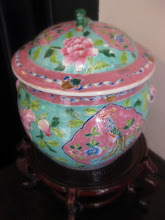Sunday, July 19, 2009
Baba & Nyonya Culture Campaign
Time: 9am-2pm
Venue: Chung Ling High School
Programs:
6th August 2009
9am- Open Ceremony
10am- Road Show
11am - Seminar
7th August 2009
9am- Photo Exhibition
10am- Quiz Competition
8th August 2009
9am- Sketch Performance, Photo Exhibition
11am - Closing Ceremony
Monday, July 13, 2009
Baba and Nyonya Cuisine
http://www.asianonlinerecipes.com/nyonya/nyonya.php
http://farm4.static.flickr.com/3622/3324753933_fd71003702.jpg?v=0
http://images.google.com.my/imgres?imgurl=http://www.badanwarisan.org.my/images/uploads/kuih.jpg&imgrefurl=http://www.badanwarisan.org.my/content/%3Fcid%3D200&usg=__Nkw__4-tT0DiiM-j7qrZbsk1LV4=&h=1536&w=2048&sz=668&hl=en&start=2&um=1&tbnid=kGEXBpSuqKe6bM:&tbnh=113&tbnw=150&prev=/images%3Fq%3Dbaba%2Band%2Bnyonya%2Bkuih%26hl%3Den%26client%3Dfirefox-a%26rls%3Dorg.mozilla:en-US:official%26sa%3DG%26um%3D1
http://images.google.com.my/imgres?imgurl=https://blogger.googleusercontent.com/img/b/R29vZ2xl/AVvXsEiQNDbyqrYnwxWPaOw9UA3ZF-MY09PJMf3oe3AfIQaPGgiujMMHdMXUqIfVaSJjzvaDKPa1p23ZbOrpCLV2rYoQLy0_VvccM8EEXq_riRIS-GutOE0bsXNIrbO2a8LSeGyCrvoGd0S6vzjF/s200/cendol.jpg&imgrefurl=http://serinyonya.blogspot.com/&usg=__E7YKhw22PUa-iFaN6DzEhJ5E6ZM=&h=200&w=184&sz=10&hl=en&start=30&um=1&tbnid=srnxzTtFz522rM:&tbnh=104&tbnw=96&prev=/images%3Fq%3Dbaba%2Band%2Bnyonya%2Bayam%2Bkapitan%26ndsp%3D18%26hl%3Den%26client%3Dfirefox-a%26rls%3Dorg.mozilla:en-US:official%26sa%3DN%26start%3D18%26um%3D1
http://images.google.com.my/imgres?imgurl=http://farm1.static.flickr.com/98/229101228_3e9358f3e1_m.jpg&imgrefurl=http://www.flickr.com/photos/5xmom/sets/72057594092913841/&usg=__XVwWKE4OjpS7jDJSca0AiNkR0mc=&h=180&w=240&sz=32&hl=en&start=19&um=1&tbnid=rji2GX8eaAEOPM:&tbnh=83&tbnw=110&prev=/images%3Fq%3Dayam%2Bkapitan%26ndsp%3D18%26hl%3Den%26client%3Dfirefox-a%26rls%3Dorg.mozilla:en-US:official%26sa%3DN%26start%3D18%26um%3D1
Marriage of Baba and Nyonya

It was not uncommon for early Chinese traders to take Malay women of Peninsular Malay or Sumatera as wives or concubines. Consequently the Baba Nyonya possessed a synergistic mix of Sino-Malay cultural traits.
Written records from the 19th and early 20th centuries show that Peranakan men usually took brides from within the local Peranakan community. Peranakan families occasionally imported brides from China and sent their daughters to China to find husbands.
Marriages within the community and of similar stature were the norm. Wealthy men prefigured to marry a chin choay: or matrilocal marriage where husband moved in with wife's family.
Proposals of marriage were made by a gift of a pinangan, a 2-tiered lacquered basket, to the intended bride's parents brought by a go-between who speaks on behalf of the suitor. Most Peranakans are not Muslim, and have retained the traditions of ancestor worship of the Chinese, though some converted to Christianity.
The wedding ceremony of the Peranakan is largely based on Chinese tradition, and is one of the most colorful wedding ceremonies in Malaysia and Singapore. At weddings, the Dondang Sayang, a form of extempore rhyming song in Malay sung and danced by guests at the wedding party, was a highlight. Someone would begin a romantic theme which was carried on by others, each taking the floor in turn, dancing in slow gyrations as they sang. It required quick wit and repartee and often gave rise to laughter and applause when a particularly clever phrase was sung. The melodic accents of the Baba-Nonya and their particular turns of phrase lend to the charm of this performance.
Religion of Baba and Nyonya
http://www.joppa-uk.org/assets/images/taoism.jpg
http://byfiles.storage.msn.com/y1pKQP02V07fsvcHueKUbcS_8pSOEGN5R9l9tTE0TG9dowfS1h7cRCeQhSSFt1ca2f-QCsLoHxO1k8
http://www.chinaculture.org/library/att/att/20040223/xinsrc_3f0a489e6d2b442d8c50979fd194a5e1_Lantern1.jpg
http://www.chinahighlights.com/image/attraction/luoyang/white-horse-temple/white-horse-temple-3.jpg
http://en.wikipedia.org/wiki/Peranakan
Clothing of Baba and Nyonya


http://en.wikipedia.org/wiki/Peranakan
http://farm1.static.flickr.com/132/388587216_688692d77a.jpg
History of Baba and Nyonya
In the 15th century, some small city-states of the Malay Peninsula often paid tribute to various kingdoms such as those of China and Siam. Close relations with China were established in the early 15th century during the reign of Parameswara when Admiral Zheng He (Cheng Ho), a Muslim Chinese, visited Malacca and Java. According to a legend in 1459 CE, the Emperor of China sent a princess, Hang Li Po, to the Sultan of Malacca as a token of appreciation for his tribute. The royalty and servants who accompanied the princess initially settled in Bukit Cina and eventually grew into a class of Straits-born Chinese known as the Peranakans.
Due to economic hardships at mainland China, waves of immigrants from China settled in Malaysia, Indonesia and Singapore. Some of them embraced the local customs, while still retaining some degree of their ancestral culture; they are known as the Peranakans. Peranakans normally have a certain degree of indigenous blood, which can be attributed to the fact that during imperial China, most immigrants were men who married local women. Peranakans at Tangerang, Indonesia, held such a high degree of indigenous blood that they are almost physically indistinguishable from the local population. Peranakans at Indonesia can vary between very fair to copper tan in color.
Peranakans themselves later on migrated between Malaysia, Indonesia and Singapore, which resulted in a high degree of cultural similarity between Peranakans in those countries. Economic / educational reasons normally propel the migration between of Peranakans between the Nusantara region (Malaysia, Indonesia and Singapore), their creole language is very close to the indigenous languages of those countries, which makes adaptations a lot easier.
For political reasons Peranakans and other Nusantara Chinese are grouped as a one racial group, Chinese, with Chinese in Singapore and Malaysia becoming more adoptive of mainland Chinese culture, and Chinese in Indonesia becoming more diluted in their Chinese culture. Such things can be attributed to the policies of Bumiputera (Malaysia), mother tongue policy (Singapore) and the ban of Chinese culture during the Soeharto era in Indonesia.
http://en.wikipedia.org/wiki/Peranakan






